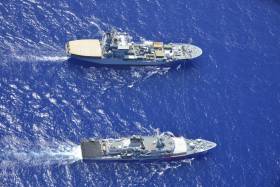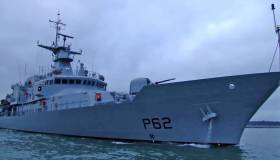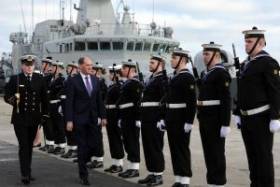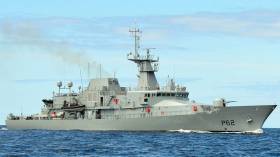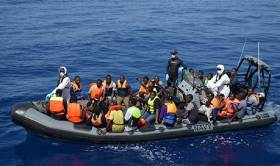Displaying items by tag: LE James Joyce
OPV LÉ James Joyce Visits USA at the Port of Boston
Irish Naval Service ship LÉ James Joyce is this week visiting the USA at the Port of Boston.
The visit forms part of its mission to do with flying the flag for Irish companies doing business in the city and in the State of Massachusetts.
Enterprise Ireland is hosting a reception on board that is focused on Irish companies as local employers and employers across the United States.
Stated the invitation: "On behalf of Lieutenant Commander Donnchadh Cahalane and David Corcoran, Head of New England and Midwest USA, Enterprise Ireland, we kindly request the pleasure of your company at an Enterprise Ireland Innovation Reception aboard the Irish Naval Ship the L.É. James Joyce.
More the Irish Echo reports of the (OPV) offshore patrol vessel.
Afloat adds the OPV arrived at the Port of Boston last weekend.
As Afloat referred to LÉ James Joyce recent Irish Sea presence in Dublin Bay, the Irish Naval Service vessel has since detained a Belgian registered fishing boat approximately 65 nautical miles south-east of Mizen Head.
The boat, Journal.ie reports, was detained (on Sunday) afternoon due to alleged breaches of fishing regulations. The LÉ James Joyce escorted the vessel to Castletownbere, Co Cork, where it was handed over to the gardaí.
This is the first vessel detained by the Naval Service in 2021.
The Defence Forces conducts at sea fishery inspections in line with the service level agreement with the Sea Fishery Protection Authority, as part of its delivery of government services to the state.
The LÉ James Joyce has been in operation since 2015. The Naval Service previously deployed it to the Mediterranean to help save migrants and refugees seeking to make their way to Europe.
LÉ James Joyce Completes 100 Day Operation Sophia Role Returns to Big Welcome Home
#NavalService - LÉ James Joyce completed a 100 day tour of duty in the Mediterranean Sea as part of EUNAVFOR-Med, Operation Sophia, having returned yesterday to its homeport of Cork Harbour to be welcomed by families and loved ones alongside the quay.
Also in attendence at the Irish Naval Service Base on Haulbowline Island, was Minister with Responsibility for Defence, Mr. Paul Kehoe T.D and by the Chief of Staff of the Defence Forces, Vice Admiral Mark Mellett DSM.
The Offshore Patrol Vessel (OPV) P60 class, Commanded by Lieutenant Commander Martin Brett, and a crew comprising of 57 members of the Defence Forces received a warm welcome from family, friends and colleagues at the base's Oil Wharf facing Cobh.
LÉ James Joyce became the third Naval Service ship deployed to the Mediterranean as part of Operation Sophia when the OPV departed in early July.
The ship's mission also included in conducted the hailing of more than 200 merchant ships, 6 friendly approach visits as previously covered on Afloat and 2 inspections.
The activities were all in support of the UN Arms Embargo off the coast of Libya, Africa as part of the EU’s comprehensive approach to disrupt trafficker/smuggler networks within the Mediterranean.
In advance of the homecoming of the OPV, Afloat.ie adds berthed at Cobh was newbuild sister LÉ George Bernard Shaw along with LÉ William Butler Yates.
#NavalService - Previously on Afloat, the Irish Naval Service P60 class LÉ James Joyce was featured conducting 'Friendly Approaches', this time the OPV is seen pictured above undergoing a replenishment at sea (RAS) exercise.
The Offshore Patrol Vessel, LÉ James Joyce was deployed last month to join Operation Sophia/EUNAVFOR (European Union Naval Force). The EU led mission is to combat and disrupt people-trafficking in the central Mediterranean Sea off north Africa.
Due to the large distances at sea during Operation Sophia, naval vessels from other participating EU member states also involve RAS. The above exercise involved the auxiliary tanker that Afloat.ie has identified as the German Navy's FGS Mosel. The 1993 built vessel is the second of a quartet of Type 404 'Elbe' class tanker tenders.
Auxiliary tankers such as 3,586 displacement FGS Mosel carry out bunkers, a nautical term to supply fuel to ships. In addition the tender is designed to provide fresh water, ammunication and general supplies that can be stored in containers as seen above on the deck.
#NavalService- LÉ James Joyce is currently in the Mediterranean having departed Cork Harbour almost a week ago to replace the first Irish Naval Service ship to be deployed to Operation Sophia during this year, writes Jehan Ashmore.
Prior to the departure last Friday, Chief of Staff of the Defence Forces Vice Admiral Mark Mellett DSM, bid farewell to the crew LÉ James Joyce. The Offshore Patrol Vessel was berthed at the oil wharf at Haulbowline Naval Base in preparation for the overseas deployment.
In recent days, LÉ James Joyce was offshore of Algeria and today is heading further eastward towards the cental Mediterranean. The second of the OPV90 class offshsore patrol vessels will takeover duties from LÉ Samuel Beckett which in March began deployment for Operation Sophia.
Last year the OPV80 class LÉ Niamh was deployed as the first Irish Naval Service ship in Operation Sophia, an EU led mission designed to disrupt people-trafficking in Libya in addition to saving the lives of migrants.
LÉ James Joyce is under the Command of Lieutenant Commander Martin Brett. A total of 57 personnel make up the crew from members of the Defence Forces. They will be on extended deployment since receiving notice that they would be sailing to assist Operation Sophia which involves other navies from participating EU member states.
Naval Service Assists In Yacht Rescue Off Cork Harbour
#Rescue - LÉ James Joyce was called on to rescue a man from a yacht in difficult conditions off Cork Harbour yesterday evening (Thursday 9 February).
As RTÉ News reports, the Naval Service OPV was diverted from a routine patrol to retrieve the solo yachtsman from his vessel, which was taking on water some 16 nautical miles southwest of Roches Point.
Waterford’s Irish Coast Guard helicopter Rescue 117 was also dispatched to airlift the yachtsman to dry land in Cork.
New International Service Medals Presented to Naval Service Crew Members
#NewMedals – New International Operational Service Medals were presented to members of the Defence Forces by Minister Paul Kehoe in Dun Laoghaire Harbour at the weekend, writes Jehan Ashmore.
The medals are in recognition of their humanitarian missions overseas which included Naval Service crew members that were deployed to the Mediterranean Sea due to the migrant refugee crisis. Other members of the Defence Forces that were deployed for example in Sierra Leone, west Africa were also awarded medals.
To mark the occasion that took place on Saturday at the Carlisle Pier was berthed LE James Joyce (P62). The offshore patrol vessel (OPV) had taken part in Operation Pontus during her Mediterranean deployment until replaced in September by a sister LE Samuel Beckett.
Less than 48 hours after the award ceremony LE Samuel Beckett rescued more than 500 migrants off the Libyan coast.
LÉ James Joyce Returns to Cork Harbour from Mediterranean
#JoyceReturns - The LÉ James Joyce has since this report by The Irish Times returned to Cork Harbour this morning. The OPV90 class ship was welcomed by Minister of State for Defence, Paul Kehoe following a deployment in the Mediterranean in which saw some 2,500 migrants rescued.
The ship was deployed on July 8th following Government approval as part of Ireland’s response to the migrant crisis. Defence Forces Chief of Staff, Vice Admiral Mark Mellett will be in attendance at the homecoming at Naval Base at Haulbowline, Cork.
The LÉ James Joyce, under its captain Lieut Cdr Neil Manning, rescued 2,491 people and recovered 21 deceased people. The crew assisted the Italian authorities in the rescue of a further 1,082 people. The vessel and its crew of 59 has been replaced by leadship class sister LÉ Samuel Beckett, which departed last week.
Naval Service Recover Bodies While Rescuing Migrants
#Recovery - In a search and rescue mission, LÉ James Joyce, tragically recovered bodies while locating 265 migrants from two rubber vessels 32 nautical miles NW of the Libyan capital, Tripoli.
A total of 5 people were declared dead, including one heavily pregnant woman.
At 9.20am LÉ James Joyce initially rescued the 106 migrants on board the first vessel before moving to a second vessel which contained 164 migrants including several people that were in need of urgent medical attention.
Those people in need of attention were immediately taken to LÉ James Joyce for treatment which was provided by both Defence Forces medical personnel and the Red Cross. Sadly, one male and four female migrants, one of whom was heavily pregnant, were pronounced dead.
The other 265 migrants are now on board LÉ James Joyce, where they are receiving food, water and medical treatment where required.
LÉ James Joyce was to transfer all 265 rescued migrants, along with the deceased, to the Italian Navy ITS Bersagliere which will transfer them to a designated Port of Safety.
Naval Service Ship Saves Over 400 Migrants At Sea
#migrantsrescue - A Naval Service vessel writes The Irish Independent at the weekend rescued more than 400 migrants as part of its operations in the Mediterranean.
The LE James Joyce and her crew were part of a mission co-ordinated by Italian Maritime Rescue to save almost 2,000 people at risk in 18 separate boats off the coast of Libya. The refugees were trying to enter Europe.
The rescue happened about 40 nautical miles northwest of the Libyan capital, Tripoli.
For more click here.





























